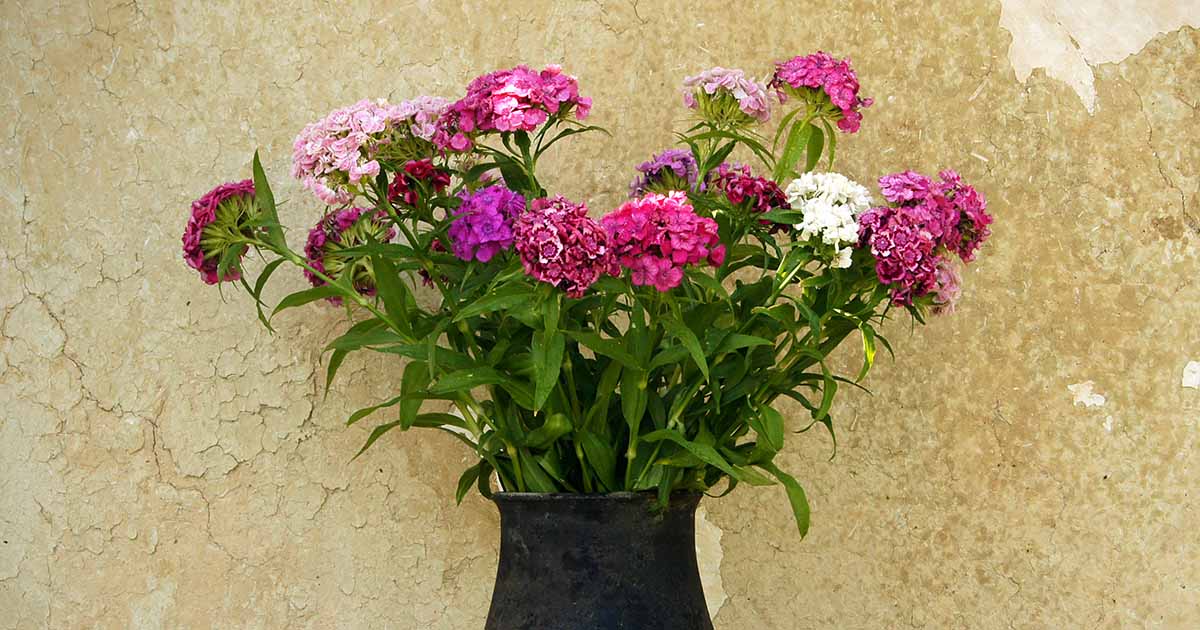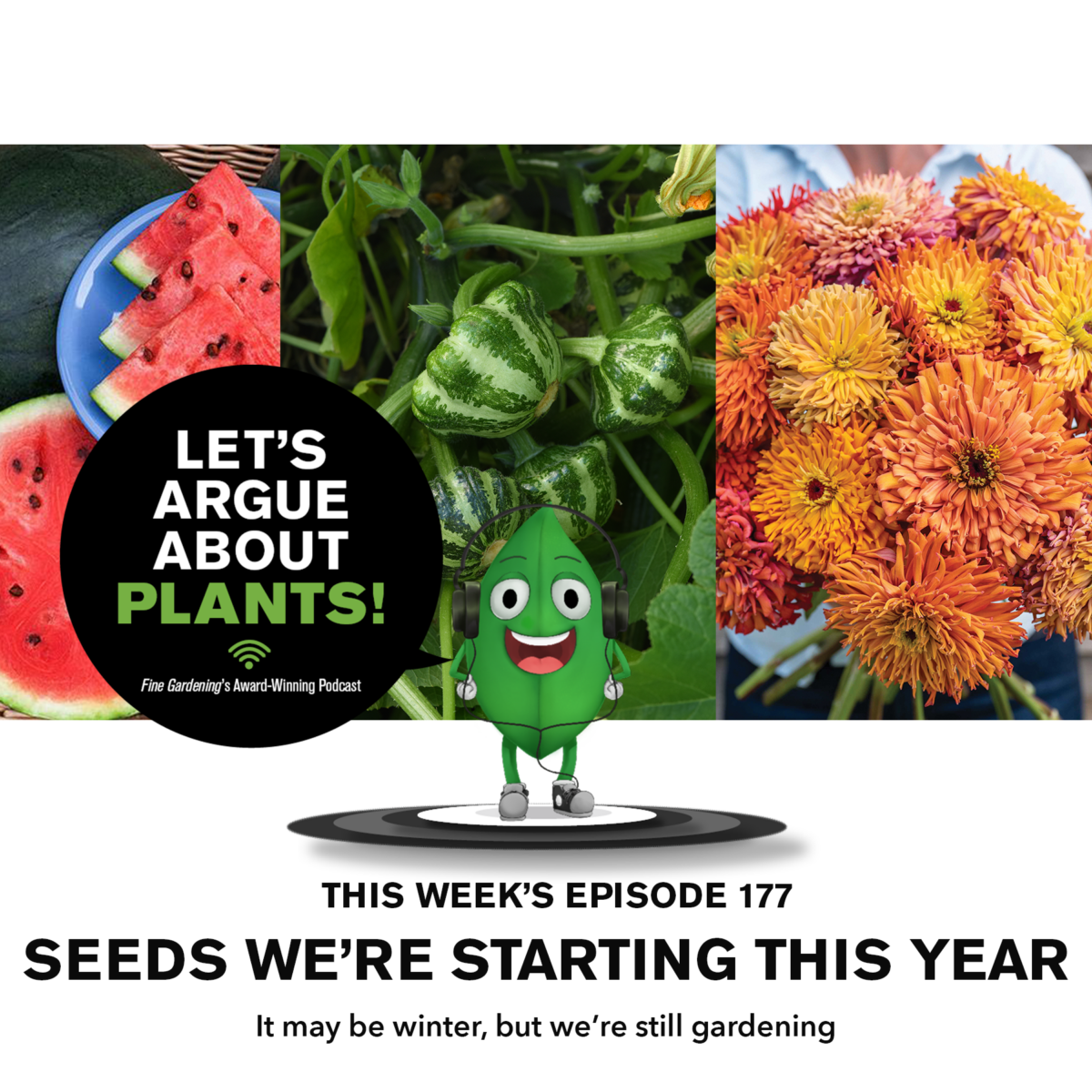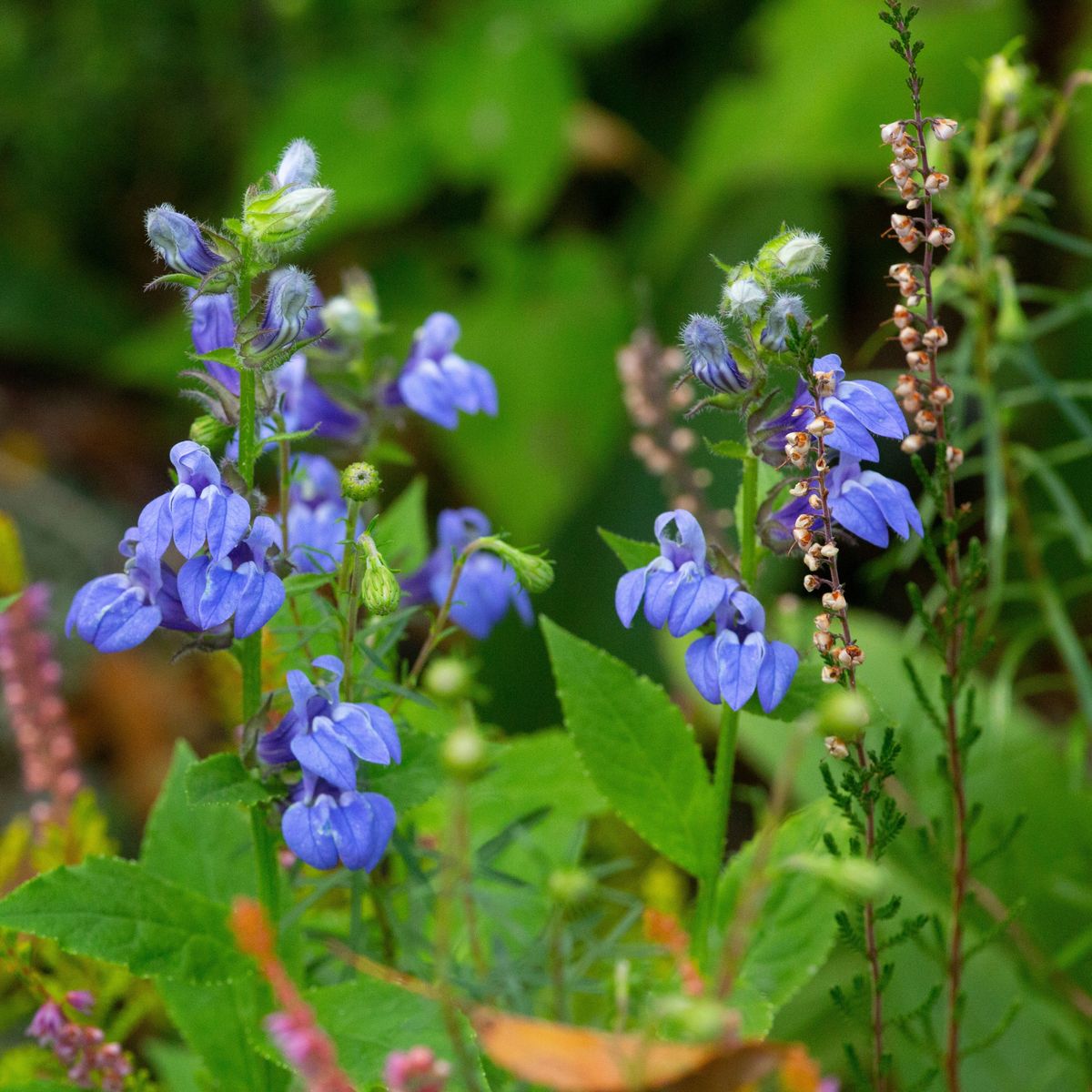A native variety called jimsonweed, or moonflower, is often seen along roadsides throughout North America.
With an alluring, slightly spicy aroma, datura is a tender perennial in Zones 8 to 10, but it is most often grown as an annual.
A prolific self-seeder, datura thrives in fertile soil with full sun and consistent watering.
However, care should be taken in growing this “witches’ weed,” as all parts are poisonous to man and beast.
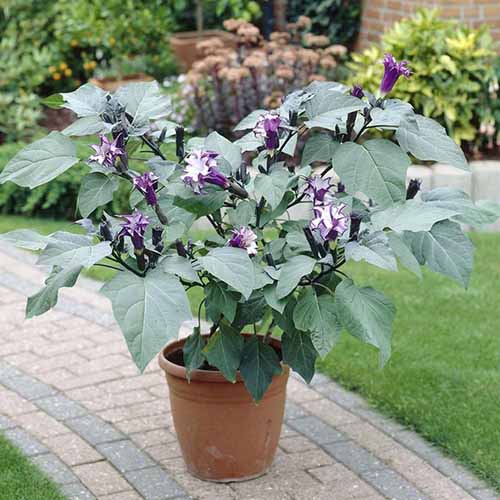
Devil’s Trumpet
You can purchase Datura arborea in three-gallon containers from Fast Growing Trees.
2. Evening Scented Stock
Evening scented stock (Matthiola longipetala) releases its intoxicating scent in the evening, and it comes in several pretty pastel shades.
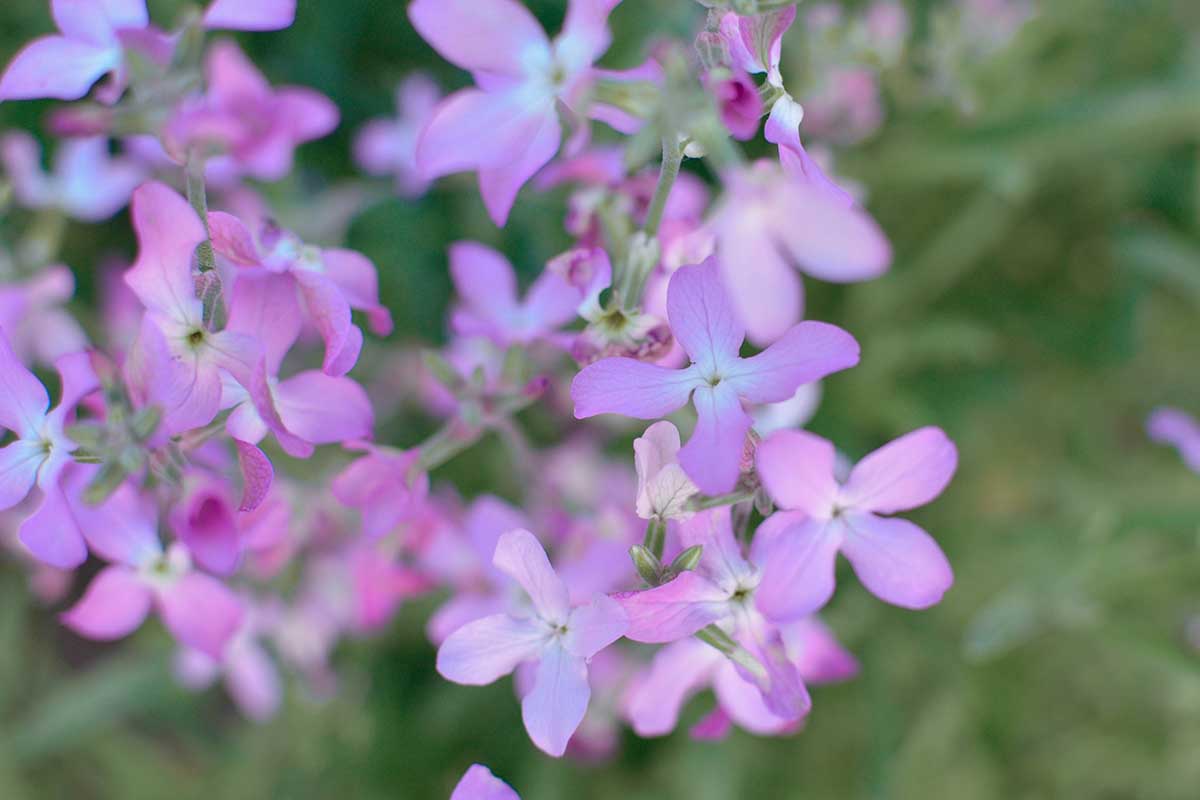
A cool weather annual, it prefers temperatures in the 60 to 80°F range, and can be grown as a winter annual in warm climates.
Plant in containers positioned near windows to enjoy their spicy-sweet cologne wafting in on the evening breeze. And provide it with some shade from intense afternoon sunlight.

Purple Evening Scented Stock
You can find 3000 M. longipetala seeds available via Amazon.
There are several other kinds of stock you may also wish to consider including the scented Matthiola incana as well as the Virginia Malcolmia maritima species.
3. Heliotrope
An annual in temperate zones, heliotrope (Heliotropium) is also grown as a perennial in warmer regions.
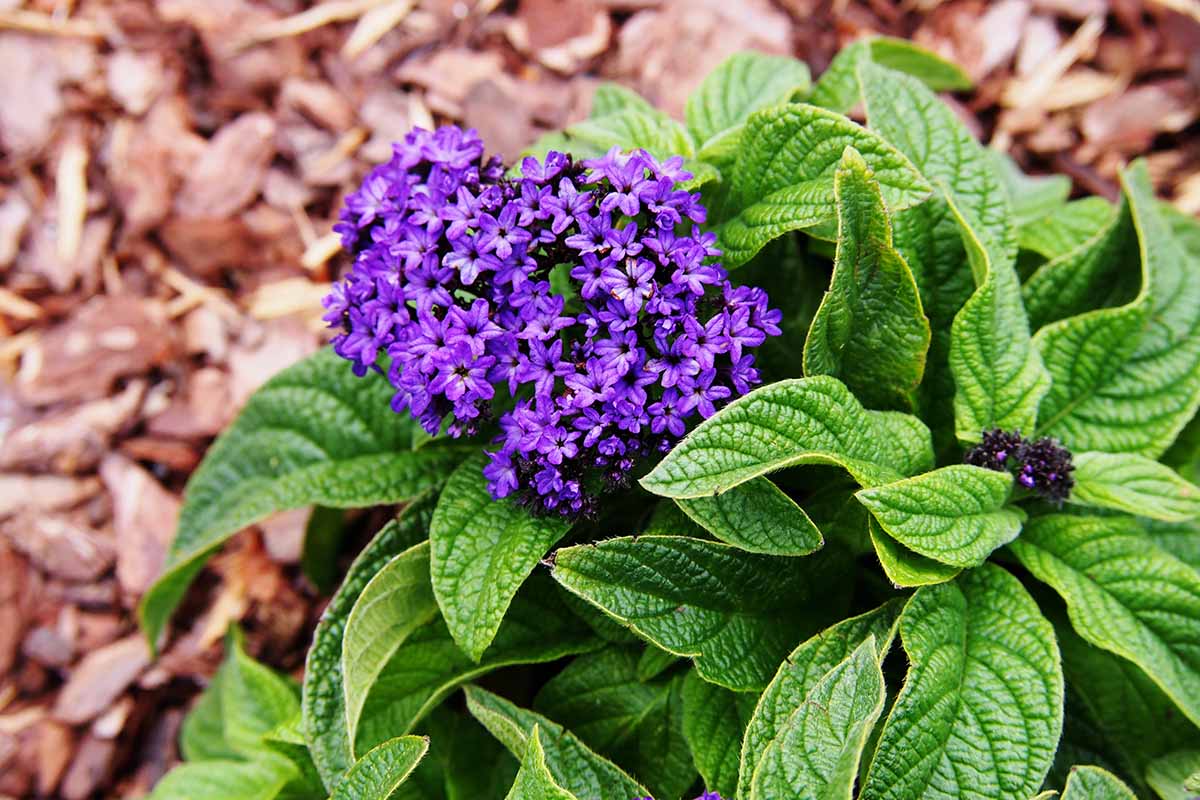
Heliotrope displays masses of showy white, mauve, or purple blossoms nestled among thick, bright green leaves with a scent reminiscent of almonds, vanilla, or cherry pie.
Hardy in Zones 9 to 11, it can be planted in the garden or in containers, and can even be moved indoors over the winter.
‘Marine’ is a dwarf cultivar that features deep purple, fragrant flowers.
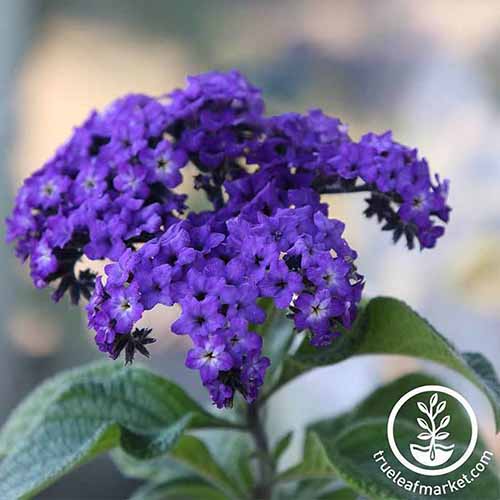
‘Marine’
You can find seeds available from True Leaf Market in packets of 100 or 1,000.
And you can find all of the details on growing this cottage garden favorite here.
4. Petunia
While many of the modern varieties of petunia (Petunia) have little or no fragrance, several of the old-timers still emit a lovely, spicy fragrance as the day’s heat cools into dusk.
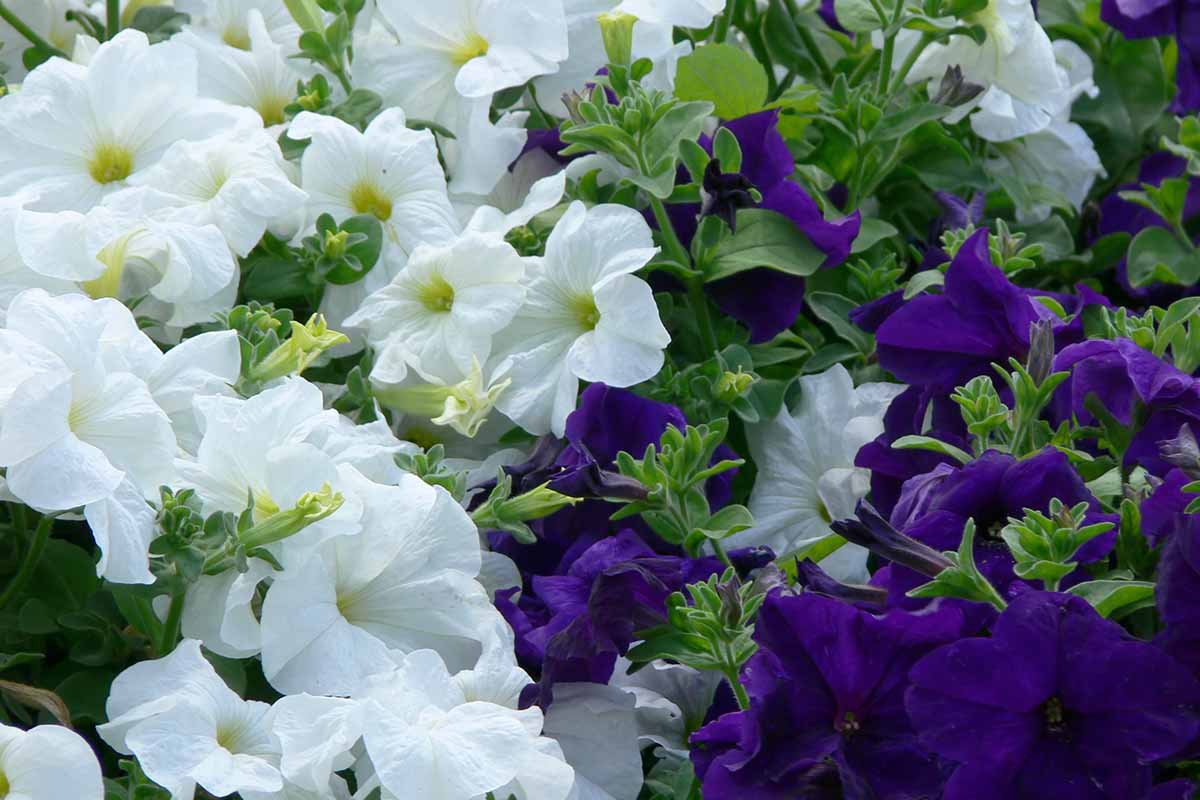
Old-fashioned purple or white vining types, Surfinias, ‘Frills and Spills,’ ‘Candyfloss,’ and “Supertunias” like ‘Priscilla’ and ‘Double Purple’ are a few that offer charming perfumes.
Petunias enjoy a fertile soil, six hours of sun each day, and regular watering. As the summer progresses, cut back leggy growth a couple of stems at a time to force more blooms.
Terrific in containers, plant plenty on or around the perimeter of your patio to enjoy on warm summer evenings.
‘Priscilla’ features light and dark purple flowers and a trailing growth habit.
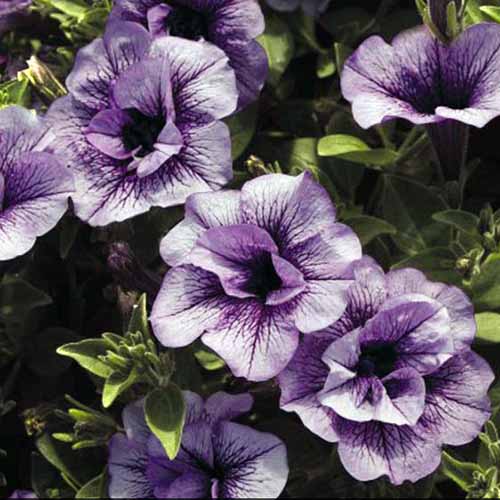
‘Priscilla’
You can find plants available at Nature Hills Nursery.
Learn more about growing petunias in our guide.
5. Sweet Alyssum
As its name suggests, alyssum (Lobularia maritima) is sweetly fragrant.
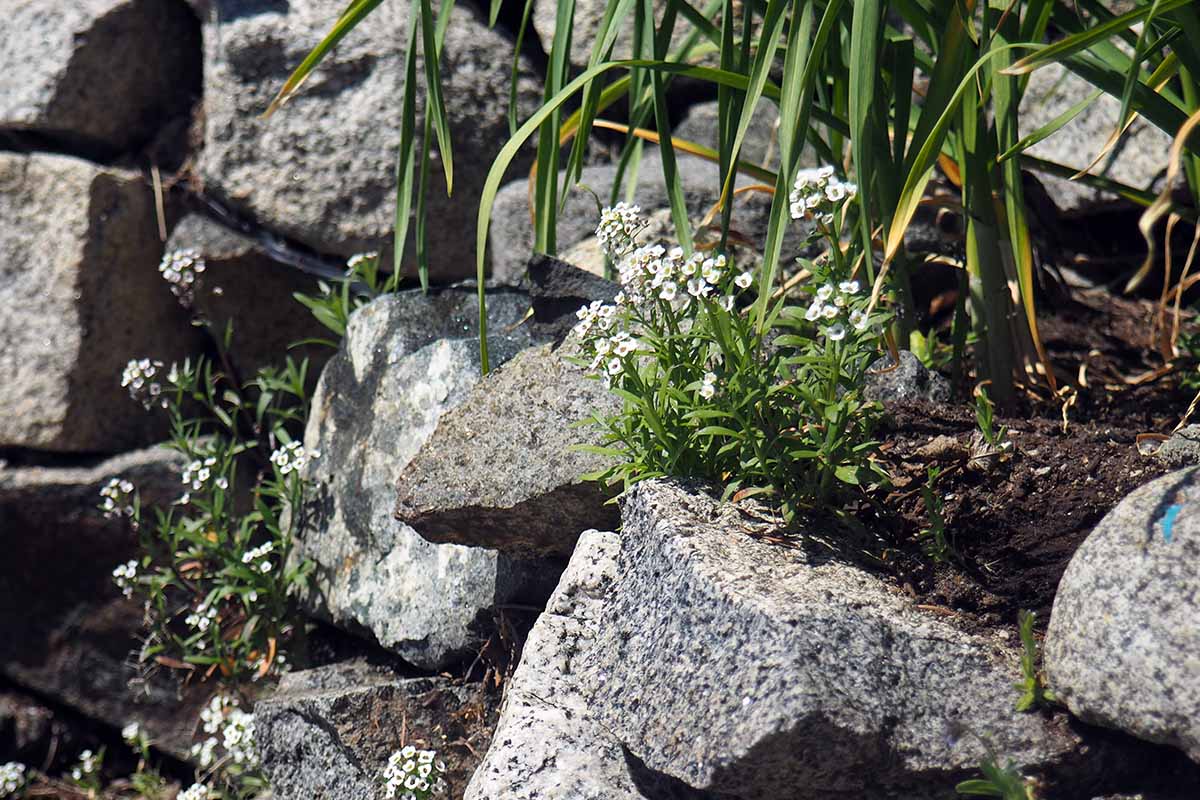
Low-growing, dense mounds produce tiny white, pink, or mauve flowers from spring until autumn. Sow in garden beds and containers, then let it self-seed freely to spread its lovely scent throughout the garden.
A great plant for edging, it’s a knockout when allowed to tumble down rockery walls, softening the look of the stones.
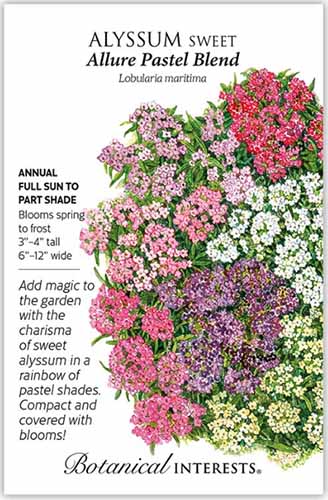
Allure Pastel Blend Sweet Alyssum
If you want to add this pollinator-favorite to your garden, you can find the Allure Pastel Blend, a mix of pastel shades, available from Botanical Interests in 700-seed packets.
You can learn more about growing sweet alyssum in our guide.
6. Sweet Peas
Here’s another cottage garden classic that produces in an array of juicy-colored blossoms, along with a heavenly, spicy-sweet scent.
Sweet peas (Lathyrus odoratus) also make an excellent cut flower, so plant enough to bring some indoors.
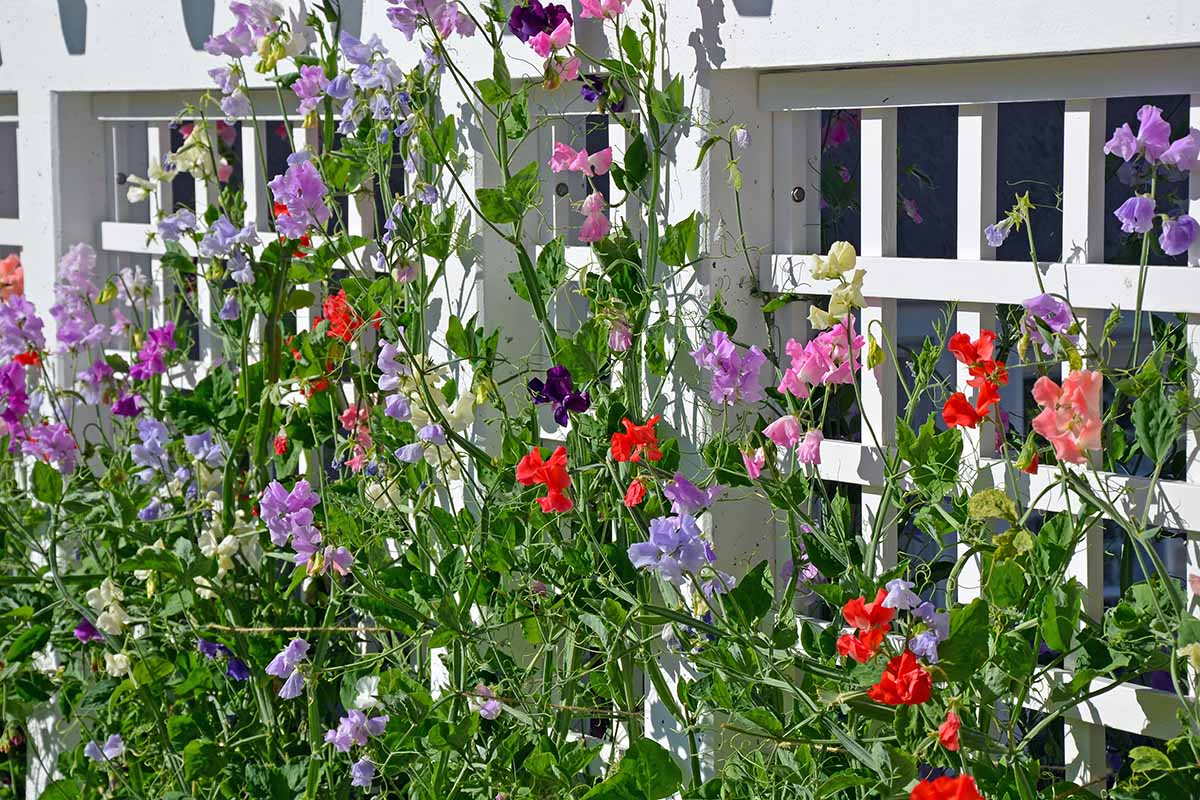
If you’re looking for impressive fragrance, stick with the annual varieties. The everlasting species are classified as perennials, but their fragrance comes in a distant second place to their annual kinfolk.
Soak the seeds overnight, and plant in late fall to overwinter in a cold frame, or in the spring as soon as the ground can be worked.
Let their heads grow in the sun, but keep roots moist and cool.
Pinch shoots on seedlings for stronger stems and more buds, and provide a support such as netting while they grow.
If you’d like to add sweet peas to your garden, try the Royal Mix, which features flowers in a variety of colors.
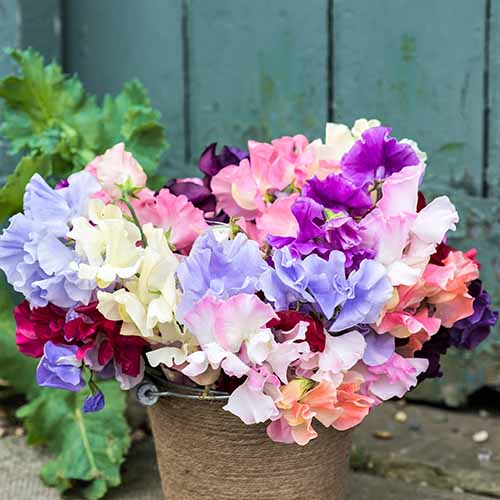
Royal Mix Sweet Peas
You can find seeds available at Eden Brothers.
Check out our complete growing guide here.
Perennials
For a repeat performance every year, try these perennial favorites.
7. Daffodils
One of the first of the fragrant bloomers to appear in the garden, daffodils (Narcissus spp.) are an irresistible harbinger of spring.
Available in single colors and combinations of white, yellow, pink, and orange, many varieties are also highly perfumed. Floral notes range from fruity to spicy, and vary in intensity from delicate to robust.
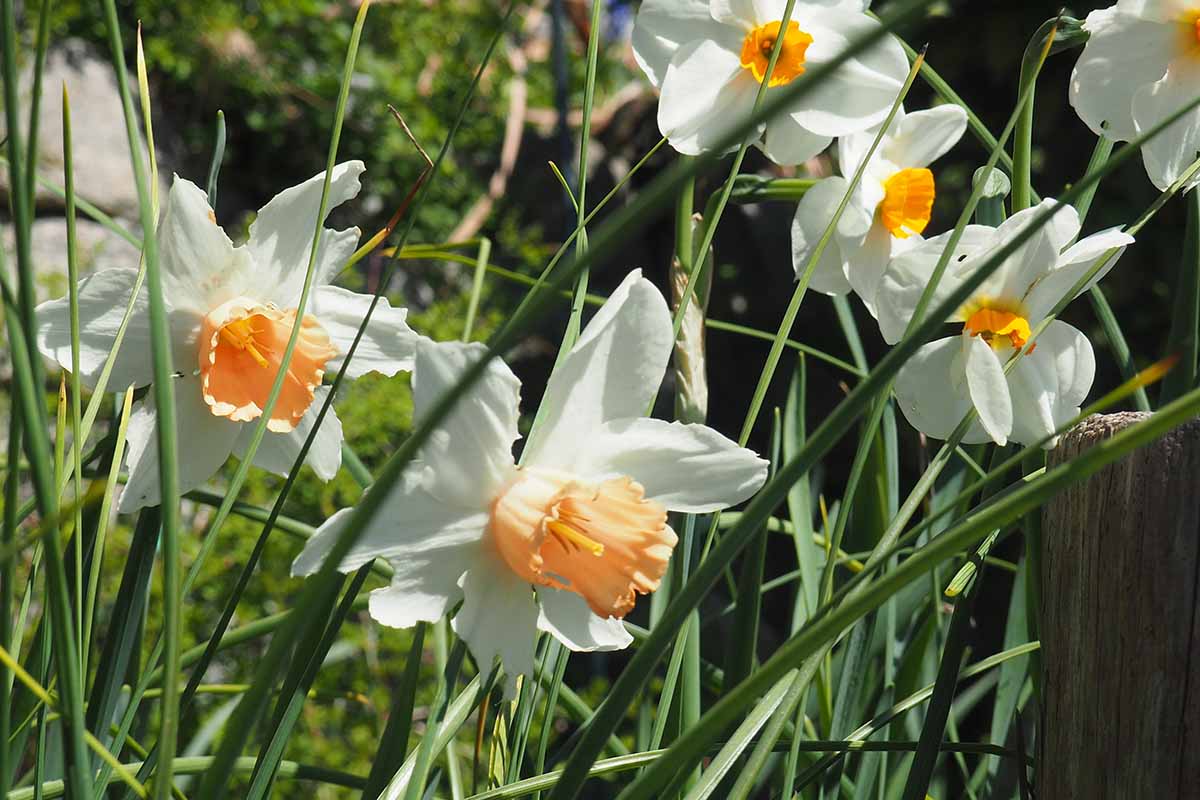
Daffodils also make a good cut flower, so plant plenty! For garden beds and containers, a mixture of early, midseason, and late bloomers will provide a delightfully long season.
They tolerate a range of soil types, and prefer a location that gets full sun to part shade. And remember to save some bulbs to force indoors, so you can delight in their heady scent over winter.
Daffodils are deer- and rodent-resistant, but are poisonous to pets.
Most varieties are reliably hardy in Zones 3 to 9.
‘Bridal Crown’ features cream-colored, two-inch flowers with a sweetly spicy fragrance.
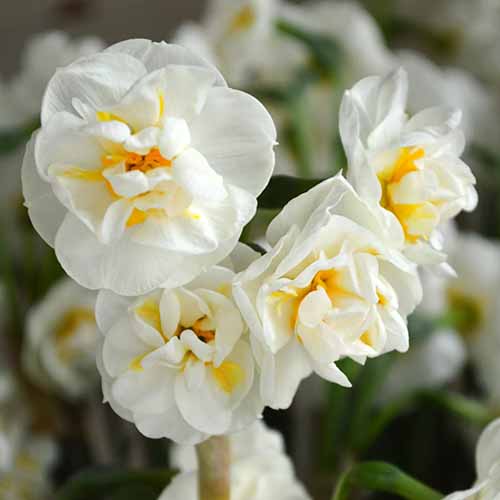
‘Bridal Crown’ Daffodils
You can find bulbs available in a variety of package sizes from Dutch Grown.
Read more about growing daffodils with our detailed guide.
8. Dianthus
Dianthus (Dianthus), or pinks, are charming and reliable growers that may be classified as a hardy annual, biennial, or perennial.
With a delicate, spicy fragrance of cinnamon and cloves, there are several varieties to choose from, including carnations, garden pinks, and sweet williams.
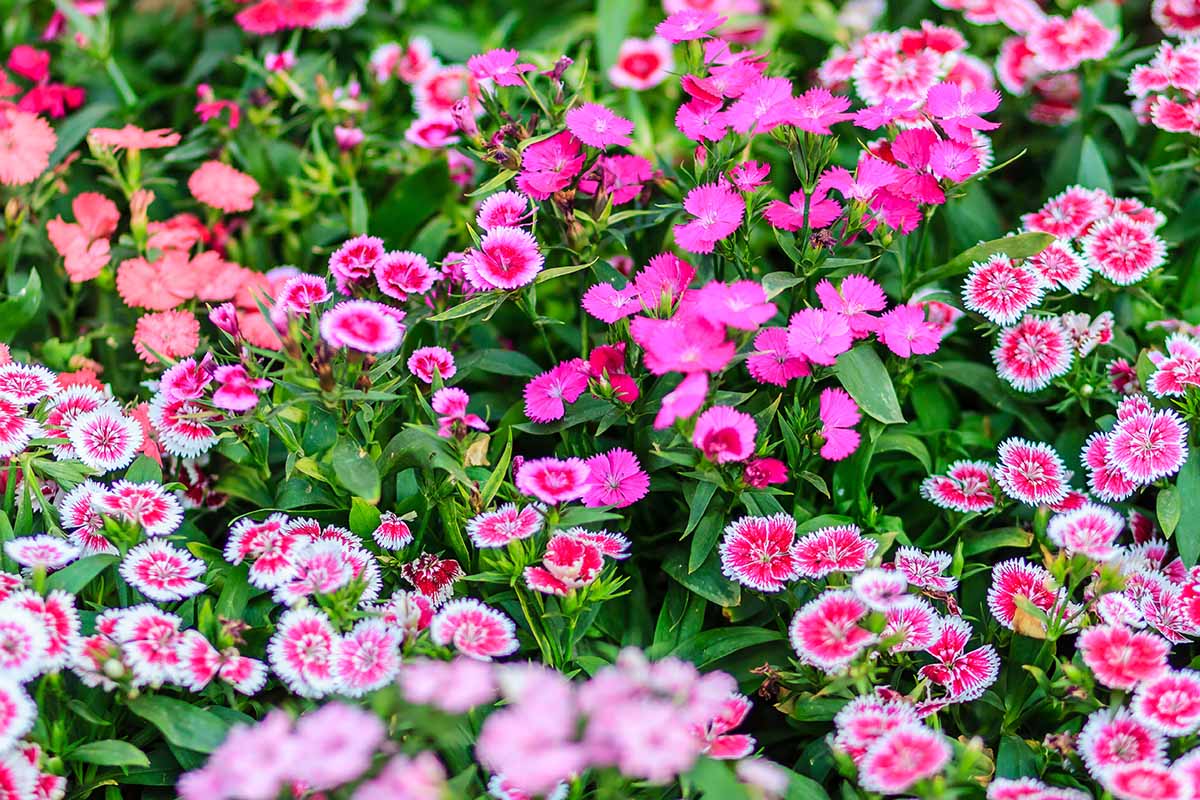
Blooms come in shades of white, pink, mauve, yellow, and red with single or double flowers. And long-stemmed varieties also make good cut flowers.
Dianthus thrive in fertile, well-drained soil and will do best with six hours of sunlight each day.
Some varieties have been bred to be seed-free, while others are reliable self-seeders. Deadhead the ones that self-sow to encourage more blooms, but do allow some to reseed – or collect the seed in fall.
Easy to care for, pinks are well suited as a border plant or they may be grown in containers. Hardy in Zones 3 to 9, dianthus will appreciate some afternoon shade in hot regions.

Telstar Series Dianthus
The Telstar Series features flowers in fuchsia, magenta, and white. You can find seeds in a variety of package sizes available at True Leaf Market.
Read our complete guide to growing these lovely flowers.
9. Lily of the Valley
Lily of the valley (Convallaria majalis) forms a spreading mass from single rhizomes, and produces springtime spires of delicate, nodding, bell-shaped blooms.
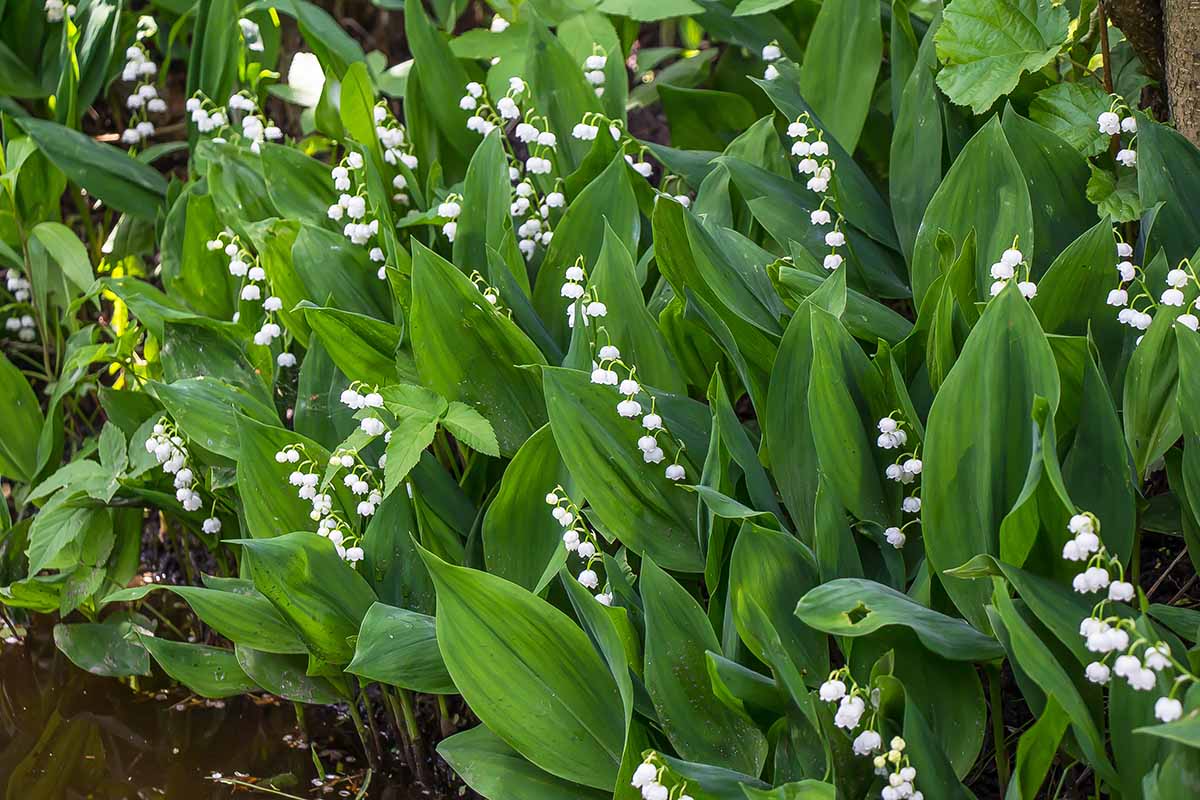
Preferring moist semi-shade, the dark green foliage is the perfect backdrop to showcase the tiny white flowers and their sweet perfume.
Visual interest is extended into summer by the small red seedpods that follow the flowers.
An ideal ground cover in naturalized areas, plant in the fall as the rhizomes need a period of cool dormancy.
Hardy in Zones 2 to 9, this is another plant that is poisonous to children and grazing pets.
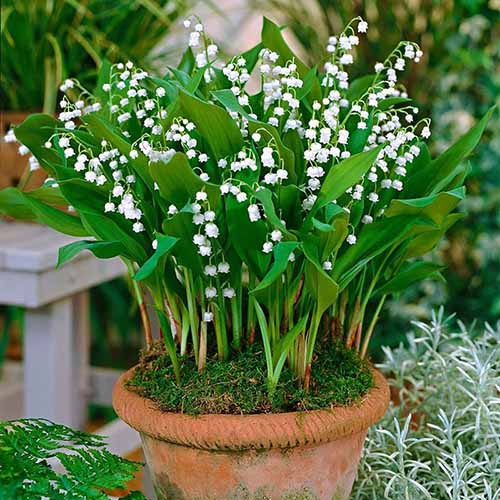
Lily of the Valley
You can find lily of the valley bare roots available at Eden Brothers.
Get our complete guide to growing lily of the valley.
10. Oriental Lilies
Oriental lilies (Lilium) are classified as true lilies, and have become one of the most popular flower in florists’ arrangements – and with good reason.
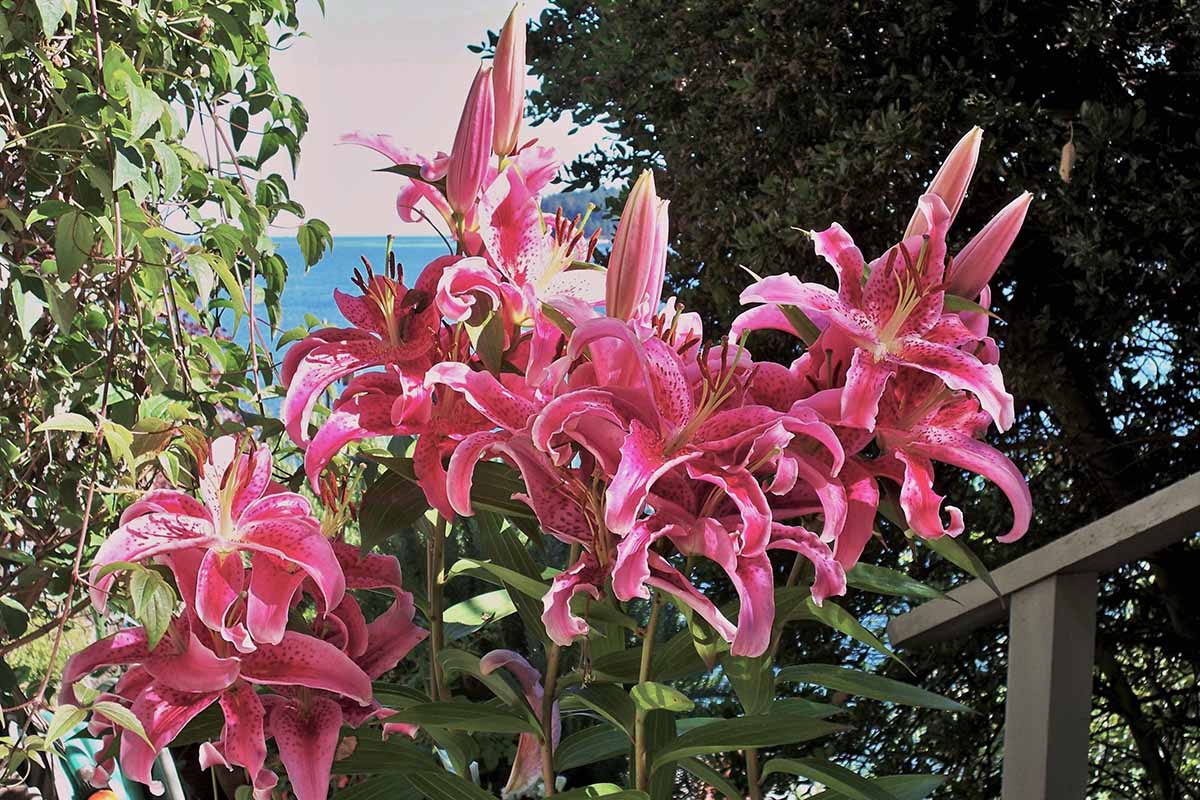
With striking colors and large, upward facing blooms, they have a deep, sensuous, and long-lasting fragrance that remains even when the petals begin to drop.
Cut flowers will last in a vase for up to two weeks, and they’re easy to grow in both the garden and containers.
Choose a selection of early, late, and mid-season varieties for blossoms and fragrance from June through to September.
Provide them with plenty of sunshine and organic soil that is slightly acidic, and top-dress with a heavy mulch in autumn.
Unfortunately, deer regard their shoots and tender buds as a special treat.
If deer are a problem, you may have to protect them by spraying with an organic orange oil, or cover them with a cloche or wire cage until they bloom.
Hardy in Zones 5 to 9, some varieties have been bred for Zones 3 and 4 as well.
The Fragrant Oriental Mix has a mixture of pink, red, and white six-inch blooms.
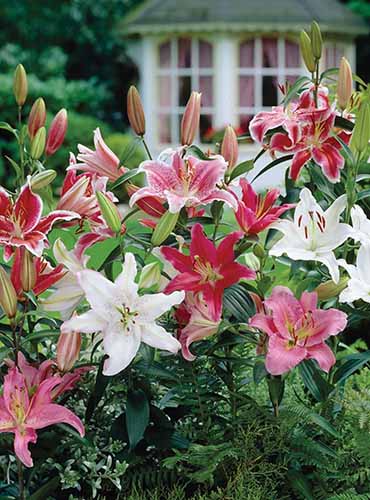
Fragrant Oriental Mix
You can find the Fragrant Oriental Mix available at Burpee.
You can learn about how to grow lilies in our guide.
11. Peonies
A carefree perennial, peonies (Paeonia spp.) are beloved for their sumptuous flower heads and sweet perfume.
Native to parts of North America, Europe, and Asia, their longevity and easygoing nature makes them a favorite with gardeners – and many varieties will survive even frigid Zone 2 winters.
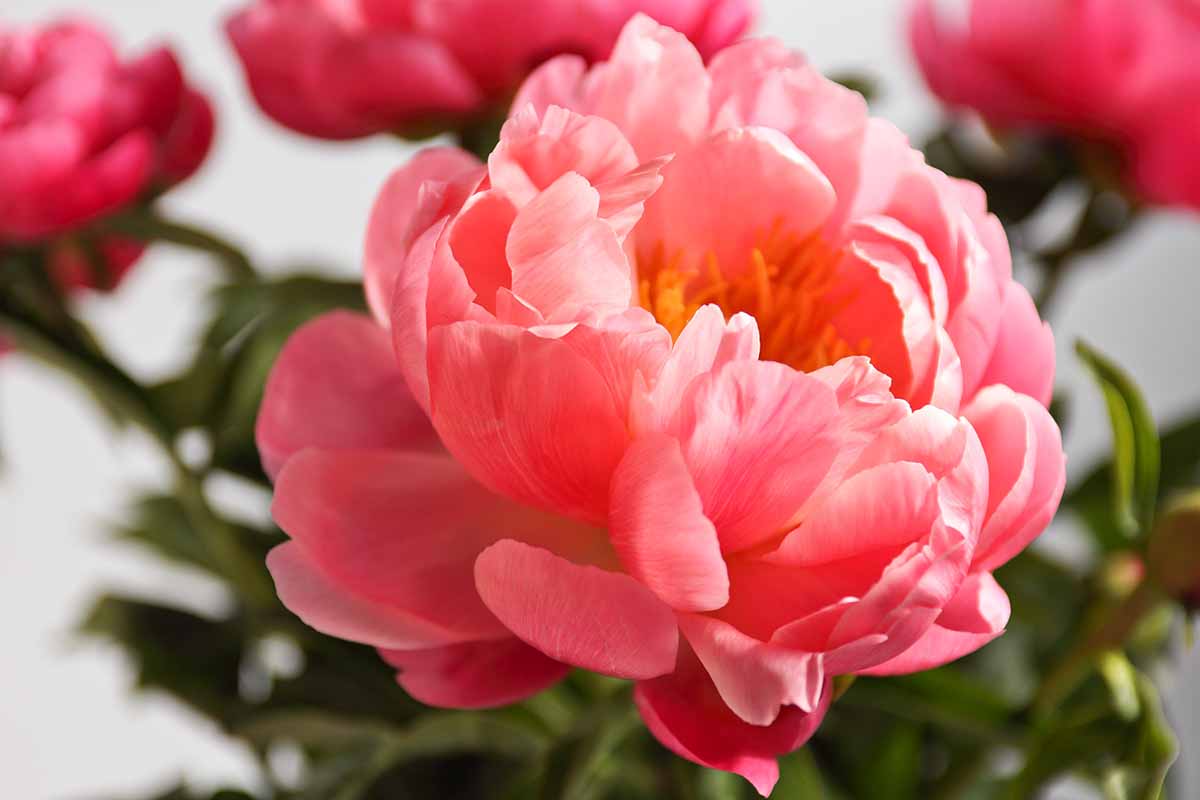
Blossom colors are available in white, yellow, pink, and red and they appear in late spring to early summer.
Single forms are intensely fragrant and don’t require as much staking as the double flower forms, which have a lighter scent but can get quite top heavy.
Peonies aren’t the longest lasting of cut flowers – but bring some into the home anyways!
Robust clumps will form in fertile, well-drained soil with a neutral pH. Give peonies a sunny exposure or part shade. They also enjoy a winter chill to set buds.
Remove spent flower heads after blooming, but don’t cut back until winter – their foliage puts on a lovely display of autumn colors. Hardy in Zones 3 to 8.
Paeonia ‘Karl Rosenfeld’ sports large, bright red double blooms that are intensely fragrant.
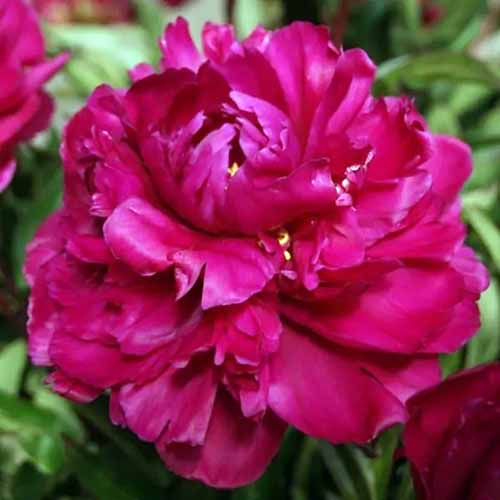
‘Karl Rosenfeld’ Peony
You can find bare root plants available at Nature Hills Nursery.
Read more about growing peonies here.
Shrubs
In addition to fragrant blooms, many perennial shrubs also have eye-catching foliage, providing texture and interest to the garden.
12. Andromeda
Andromeda (Pieris japonica) is a hardy evergreen shrub that comes to us from Japan.
In early spring, it develops arching panicles of small white blossoms similar in shape, size, and fragrance to lily of the valley.
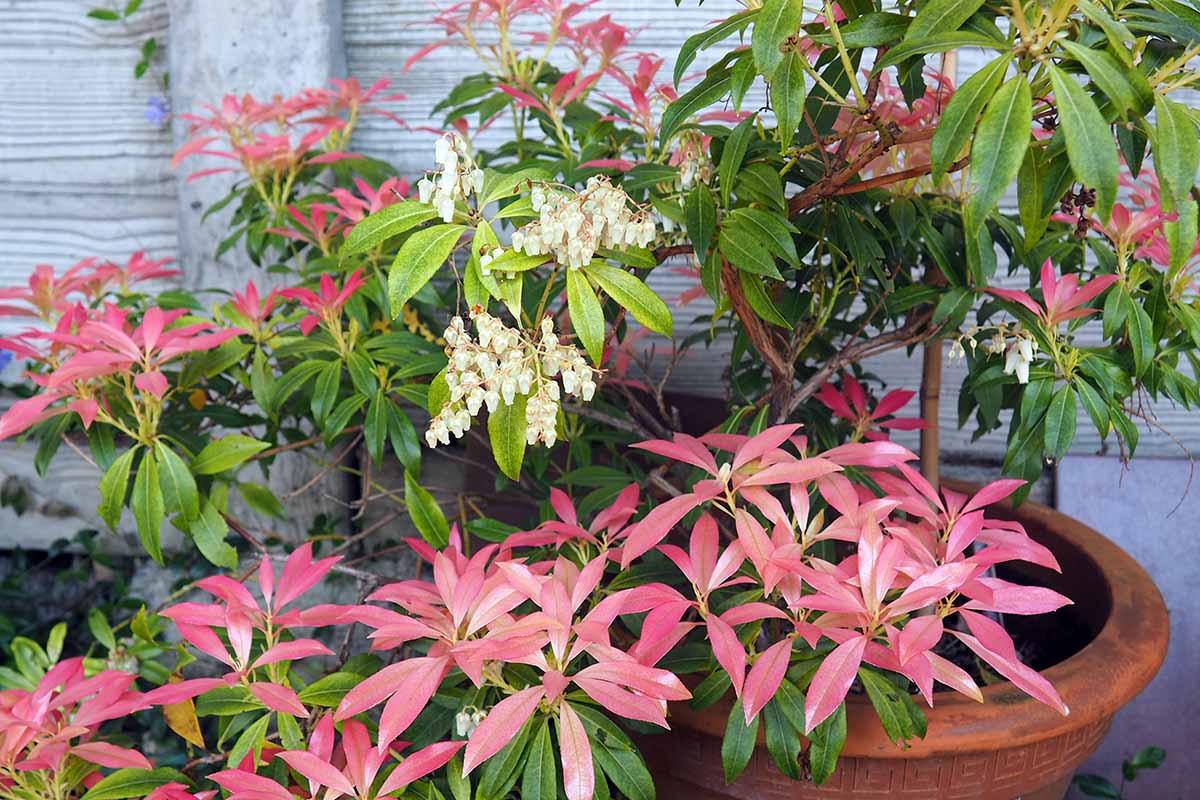
Before the flowers are finished, new growth appears in blazing shades of pink, orange, and red that turn to green by summer.
Ideal as a foundation or specimen plant in garden beds, they also perform admirably in large planters.
If left ungroomed, shrubs can grow to 10 feet, but its shape and size is easily maintained with a winter pruning.
Andromeda prefers slightly acidic soil in a sheltered location out of the wind. Hardy in Zones 6 to 9, note that this plant is poisonous to children and pets.
‘Mountain Fire’ has bright red foliage that offsets the pinkish-white flowers, and grows to a mature height of four to eight feet.
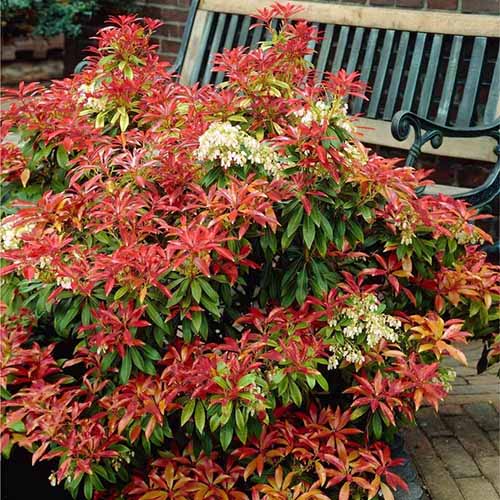
Pieris japonica ‘Mountain Fire’
You can find plants in three-gallon containers available from Fast Growing Trees.
13. Azaleas
Azaleas belong to the genus Rhododendron and are native to the temperate regions of North America, Europe, and Asia.
Several of the deciduous azaleas have pastel flowers that are strongly scented, with fragrances ranging from sweet fruitiness to sultry spiciness.
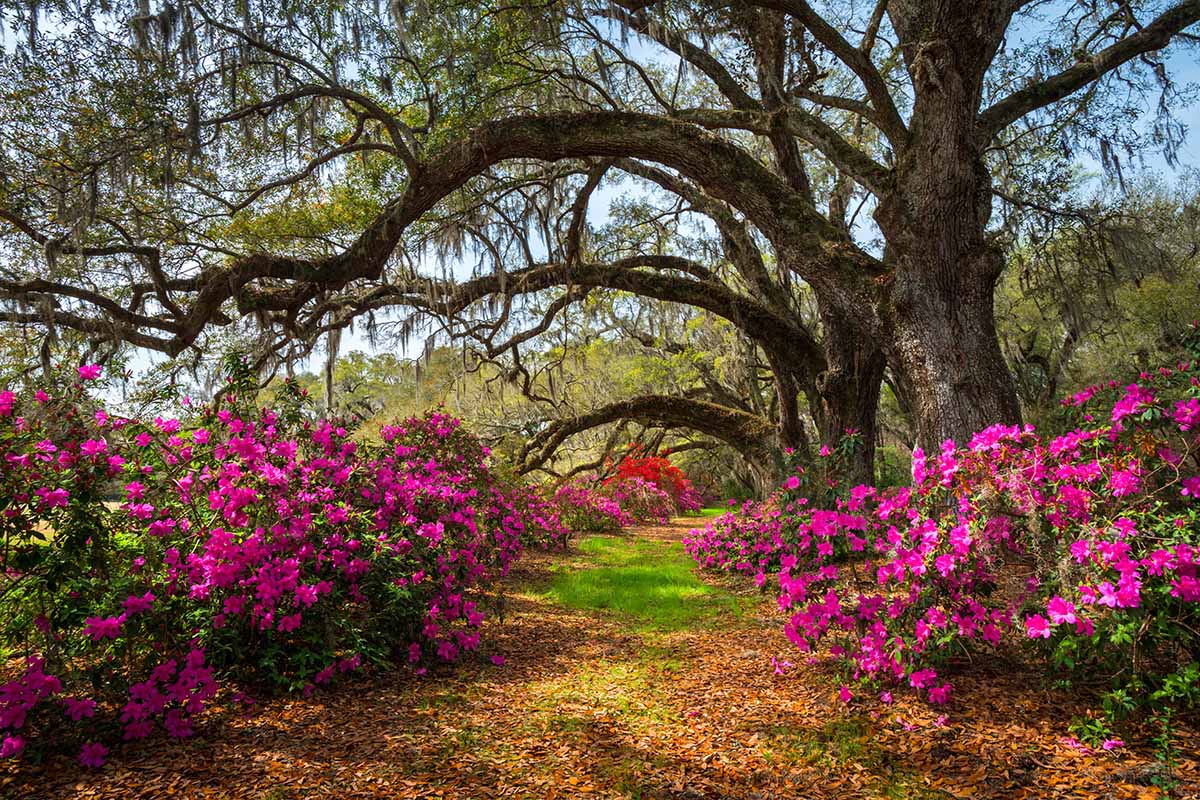
The sweet azalea (R. arborescens) hails from northeastern North America and bears large, funnel-shaped white flowers in early to midsummer, with a scent reminiscent of heliotrope.
Hardy in Zones 5 to 9, it’s very effective as a border hedge.
For a spicy scent of cinnamon and cloves, try the Western azalea (R. occidentale).
Native to the West Coast of North America, striking trusses of flared pink blossoms appear before the leaves, giving maximum visual impact along with its heady fragrance. And in autumn, the leaves glow in incandescent shades of orange and scarlet.
Azaleas are striking in groups, and many are well-suited to naturalized settings. Most deciduous varieties need excellent air circulation and regular watering to prevent powdery mildew. Hardy in Zones 7 to 9.
With yellow flowers that have a sweetly floral scent, ‘Lemon Lights’ is a cold-hardy cultivar suitable for growing in Zones 4 to 8.
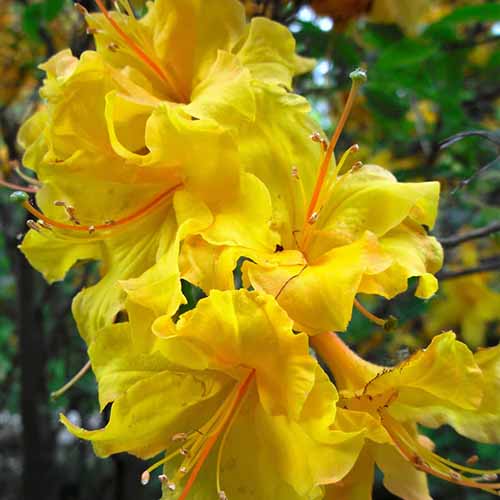
‘Lemon Lights’ Azalea
You can find ‘Lemon Lights’ in three-gallon containers available at Fast Growing Trees.
Learn more about growing azaleas here.
14. Gardenia
A native of China, Japan, Africa, and Oceania, the gardenia (Gardenia spp.) is prized for its delightful, waxy, white, and long-blooming flowers with their sweetly tropical aroma.
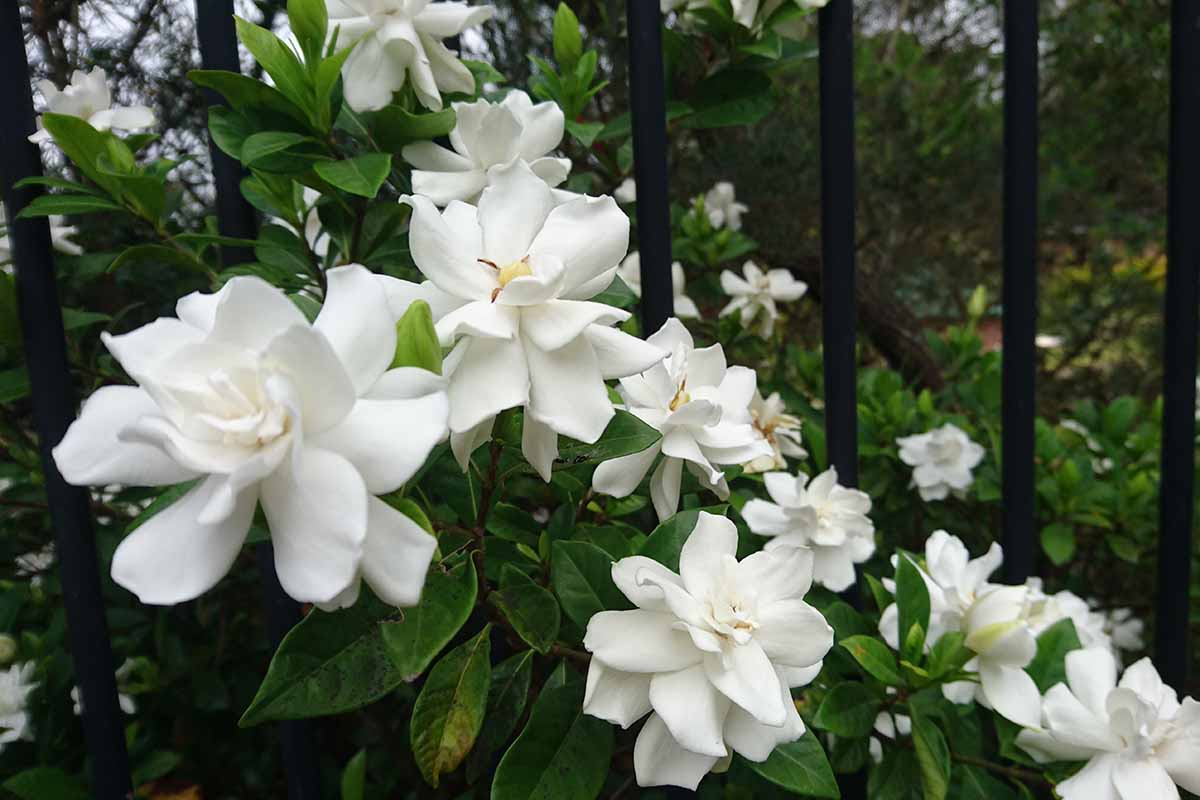
An evergreen with thick, dark green, glossy leaves, gardenias bloom from midspring to midsummer, preferring bright but indirect light and high humidity. Blossoms are followed by clusters of flame-orange berries.
To best enjoy their fragrance, use them in plantings for privacy screens or hedges close to walkways and paths. Hardy in Zones 8 to 10.
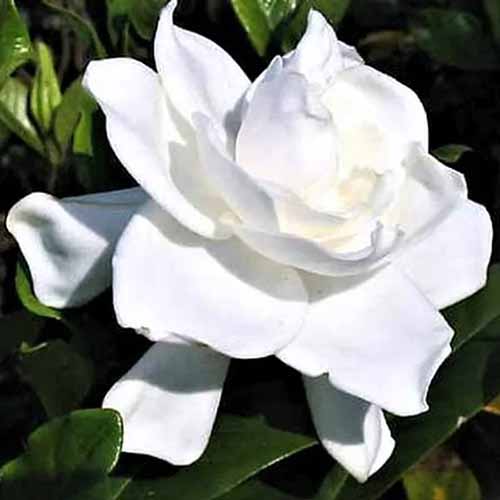
‘August Beauty’ Gardenia
‘August Beauty’ grows to a mature height of three to five feet and a two- to three-foot spread. You can find plants in quart-sized and #3 containers at Nature Hills Nursery.
Find tips on growing and caring for gardenia flowers here.
15. Honeysuckle
Honeysuckle (Lonicera spp.) are twining vines and shrubs native to temperate regions of the Northern Hemisphere.
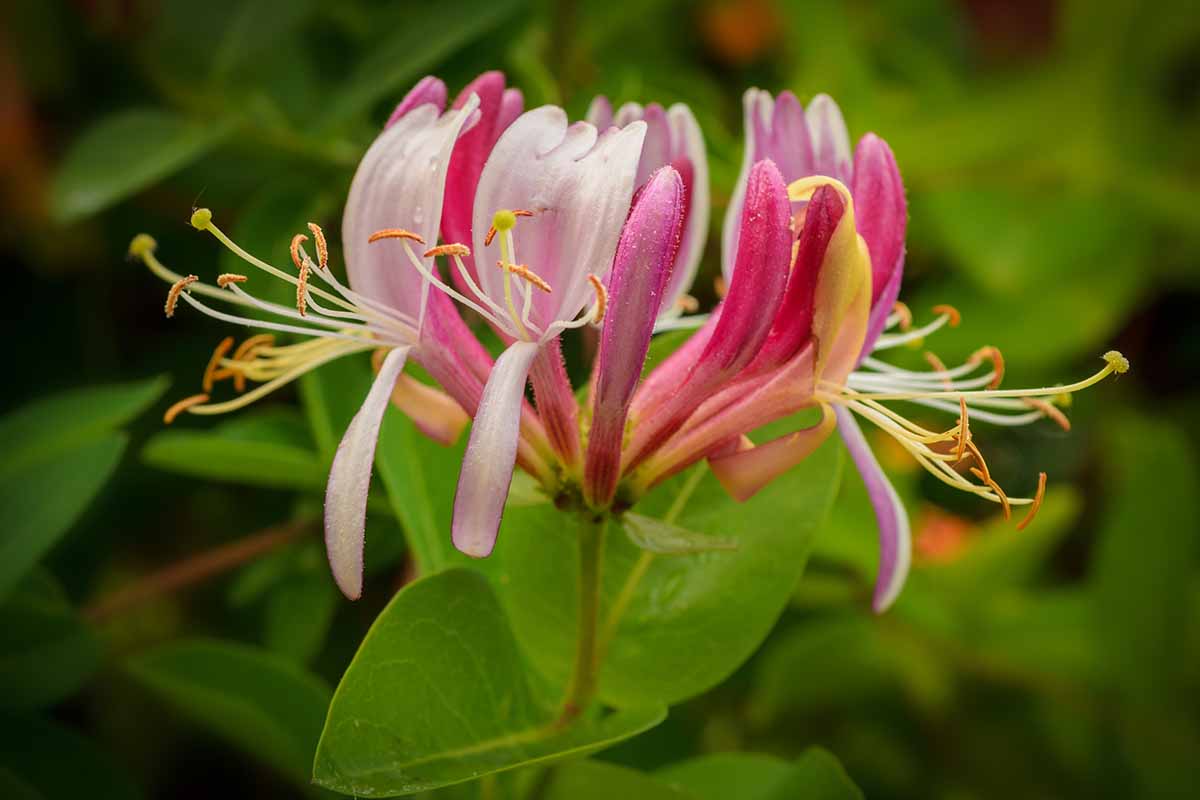
With close to 200 species in existence, most are deciduous with only a few being evergreen.
Highly popular with those who enjoy fragrant plants, their tubular flowers are sweetly scented and produce a sweet, honeylike nectar – a favorite of hummingbirds.
Colors range from creamy white, yellow, and orange to pink, and red, and elongated fruits in shades of red, blue, and black follow the blossoms – with many varieties being edible for birds and wildlife.
Honeysuckle prefers full sun and are adaptable to a variety of soil types. Provide a support for the twining varieties to climb on, and prune in winter to control their size. Hardy in Zones 4 to 9.
L. periclymenum ‘Peaches and Cream’ has five-lobed pink, white, and magenta blooms. Vines grow six to 10 feet long.
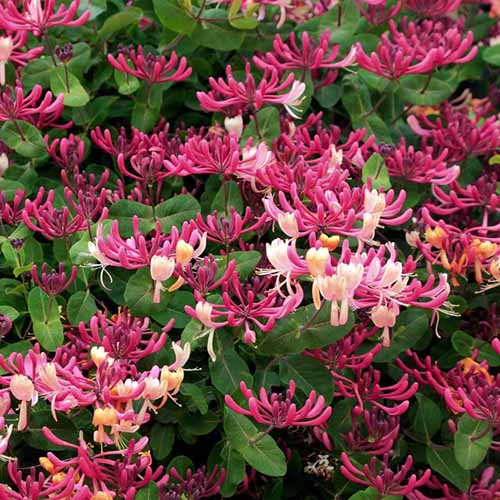
‘Peaches and Cream’ Honeysuckle
Pick up ‘Peaches and Cream’ in one-quart and three-gallon containers from Fast Growing Trees.
Read more about growing and propagating honeysuckle in our guide.
16. Lilacs
The lilac (Syringa vulgaris) is well-known for its heady perfume and beautiful, exuberant blossoms of white, mauve, purple, and yellow – with the French hybrids being the most renowned for their large blossoms and sweet scent.
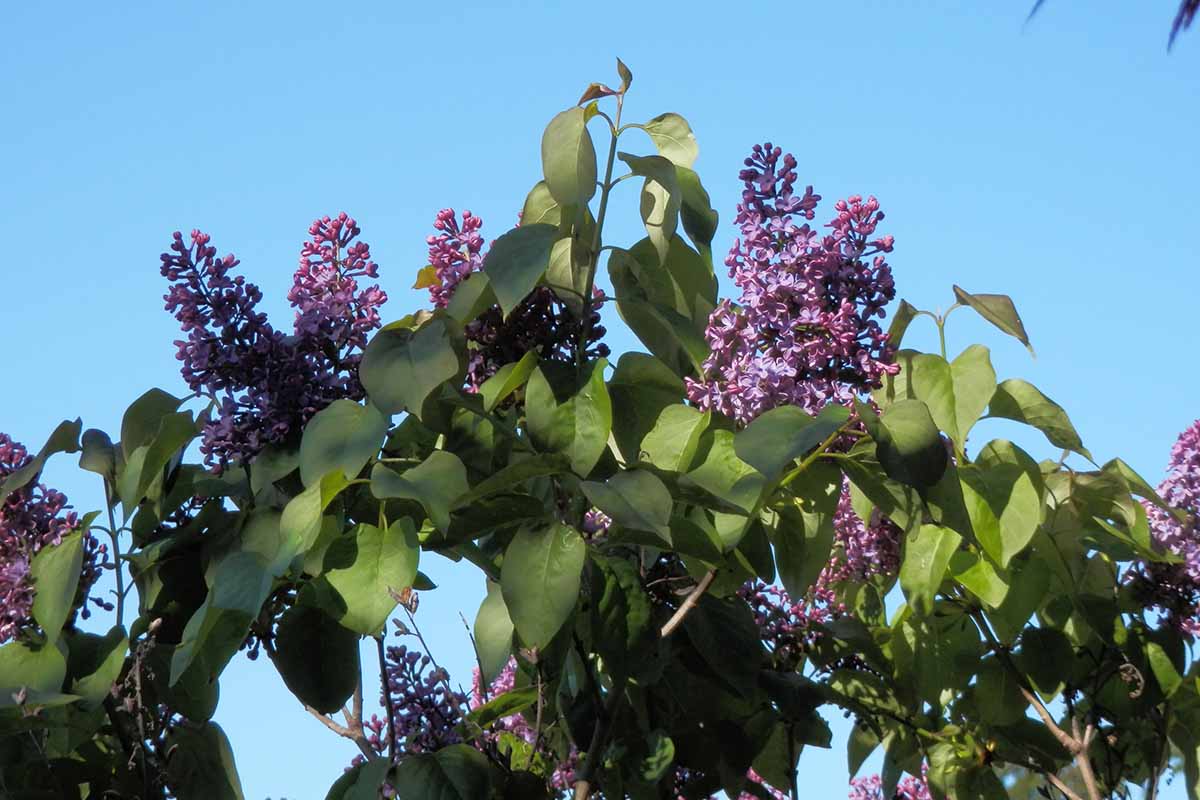
They prefer well-drained soil with plenty of sunshine, and will produce more blooms if left unpruned, as blossoms grow on old wood. However, they will benefit from a light grooming right after flowering is finished.
Lilacs flower for only three weeks in late spring, but planting a few different varieties will extend their overall season into early summer.
Hardy in Zones 3 to 7, lilacs enjoy a period of cold dormancy – although some species have been bred to grow in Zones 8 and 9.
‘Tiny Dancer’ is a dwarf cultivar that grows to a mature height of four to five feet tall and features light pink flowers. It is hardy in Zones 3 to 8.
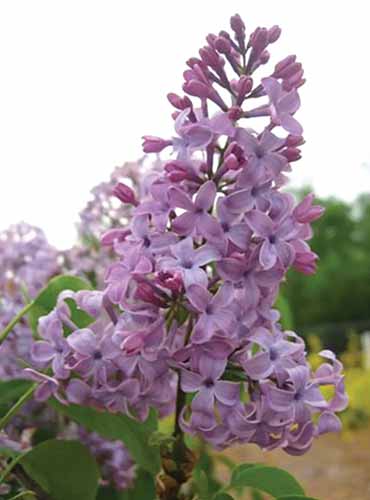
‘Tiny Dancer’ Lilac
You can find bare roots available from Burpee.
Read more about growing and caring for lilacs.
17. Quince
Flowering quince (Chaenomeles spp.) is a reliable cold weather performer, with early blossoms in March and April. Available in shades of white, pink, salmon, orange, and red, these are an important food source for early returning hummingbirds.
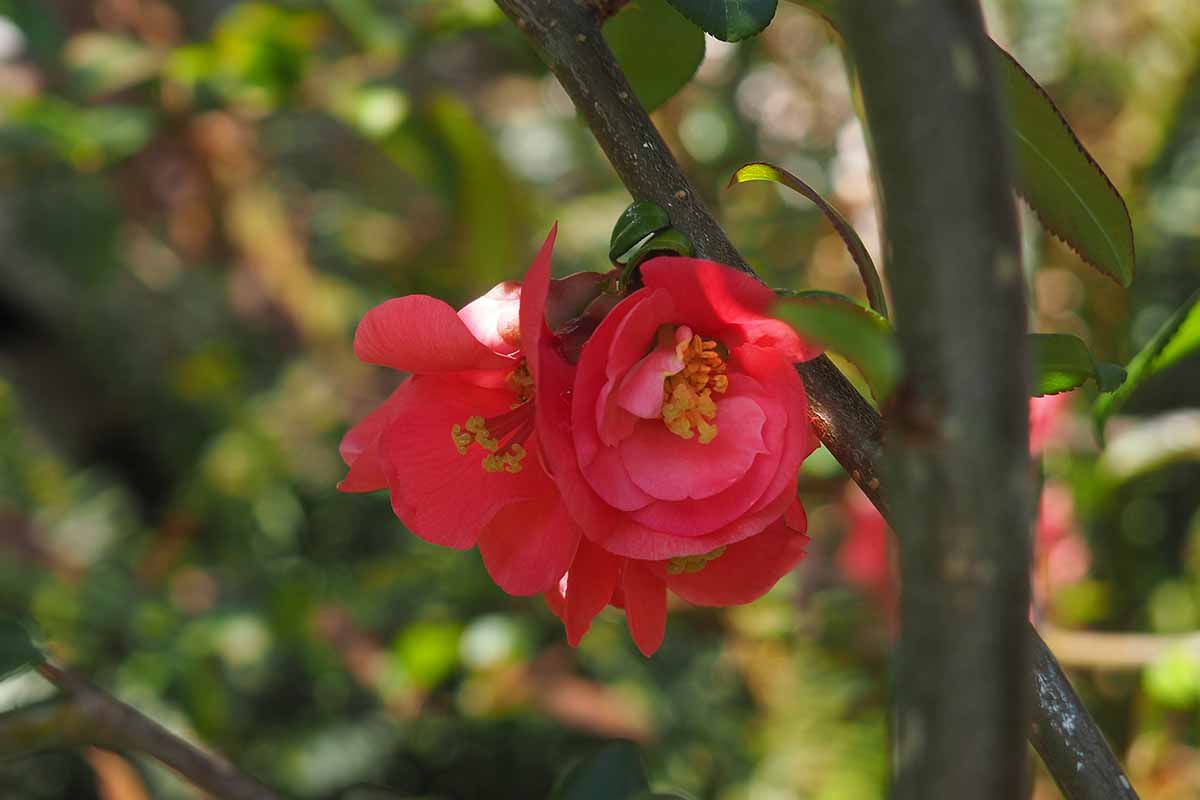
Their fragrance is delicate and fruity, and an old-style quince will produce lemon-yellow fruit that’s good for jelly and marmalade. Most of the newer varieties have been bred to produce neither fruit or thorns.
Reliable in Zones 4 to 9, cultivars have been developed for Zone 3 as well.
Double Take Pink™ aka C. speciosa ‘Pink Storm’ is a thornless variety with large double flowers that matures to a compact height of three to four feet tall.
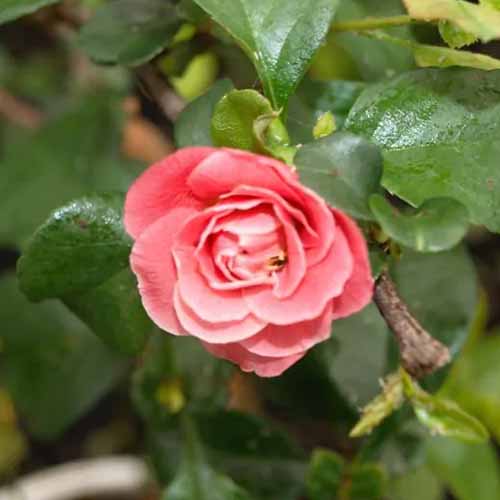
Double Take Pink™ Flowering Quince
Plants are available at Nature Hills Nursery.
Learn more about growing flowering quince here.
18. Star Jasmine
Star jasmine (Trachelospermum jasminoides) is an evergreen vine with glossy, oval leaves.
A native of south Asia, its scent is often described as the perfume of love – and when you catch its aroma on the breeze, it will stop you in your tracks!
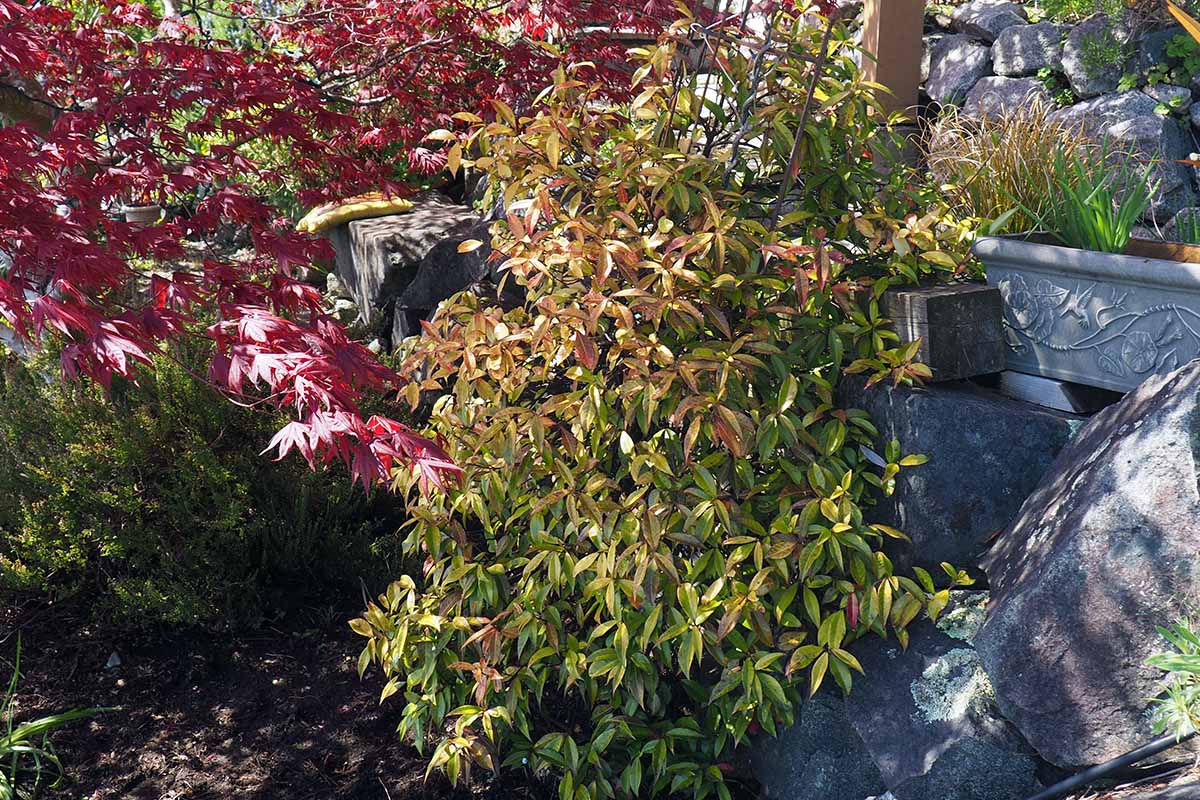
Small, star-shaped white flowers bloom in early summer, and the leaves give pretty winter color in shades of orange, red, and burgundy.
Star jasmine needs a sheltered spot with well-drained soil, and a bit of shade from intense afternoon sunlight will help its performance.
Drought tolerant once established, it can’t abide wet feet.
A dazzling, twining climber, it will grow upwards of 25 feet on a brick wall. But it also makes a superb ground cover, spreading out 10 feet with a two-foot height. Hardy in Zones 8 to 11.
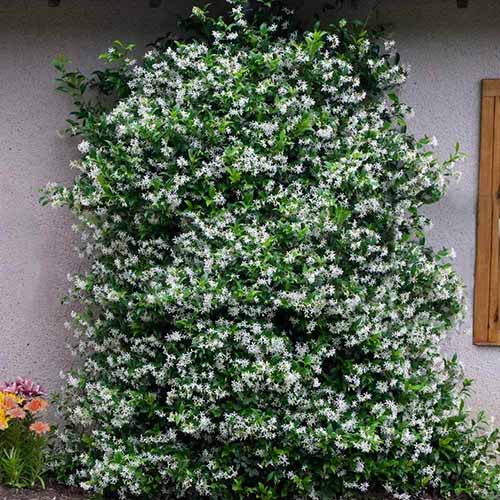
Star Jasmine
You can find star jasmine in one-, two-, and three-gallon containers from Fast Growing Trees.
19. Viburnum
For outstanding value, it’s hard to beat this master of versatility, the viburnum (Viburnum spp.).
With close to 200 species, viburnums come in both evergreen and deciduous forms. Heights vary from ground cover to tall shrubs.
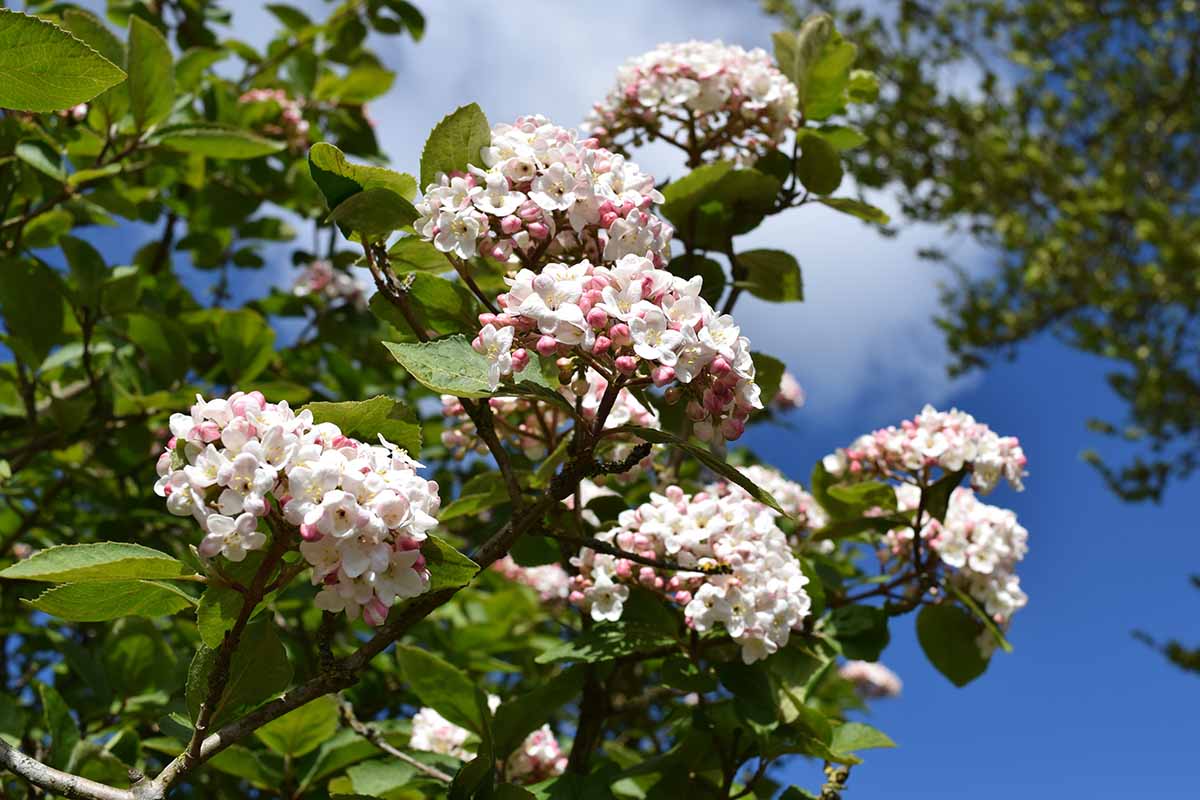
Some blossom as early as mid-winter, and many have fragrant flowers that are followed by colorful berries, plus gorgeous fall foliage.
Several species provide three or even four seasons of interest, and viburnum drupes provide needed food and moisture for winter birds.
Try V. carlesii, or Korean spice, a deciduous variety that starts with red buds in spring followed by pink, then white clusters of deliciously fragrant flowers.

Korean Spice Viburnum
You can pick up Korean spice available in two- and three-gallon containers from Fast Growing Trees.
These are replaced by dark blue or black drupes by late summer. And in autumn, the foliage is resplendent in shades of copper, red, and burgundy.
Hardy in Zones 2 to 9, viburnums are a good choice for problem areas as they’re very adaptable to adverse soil and light conditions.
Get more tips on growing viburnum shrubs here.
The Nose Knows
While fragrant flowers might not last as long as unscented ones, it would be hard to imagine a garden without them – like the sky without brilliant, but brief, sunsets.
And Mother Nature does indeed provide us with an abundance of scented blossoms to choose from!
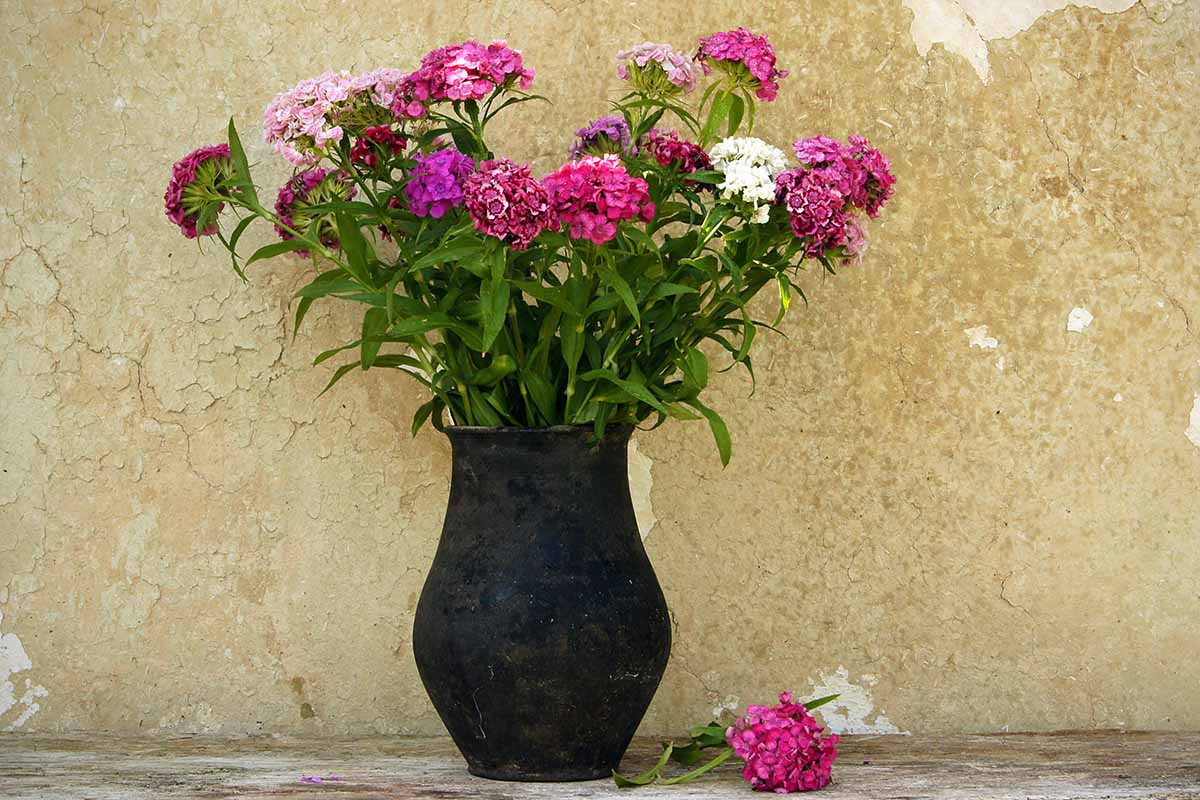
From annuals and perennials to shrubs and vines, with a bit of planning, you can enjoy their perfume in almost every month of the year.
Remember to choose what works for your hardiness zone, provide them with the growing conditions they need, and overlap their bloom times so you’ll never be without a touch of scent.
Any favorite flowering fragrances you’d like to mention? Let us know your ideas in the comments section below!
And for more flower options for your garden, be sure to check out these guides next:

